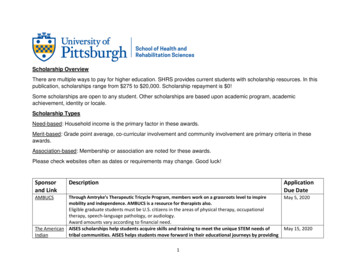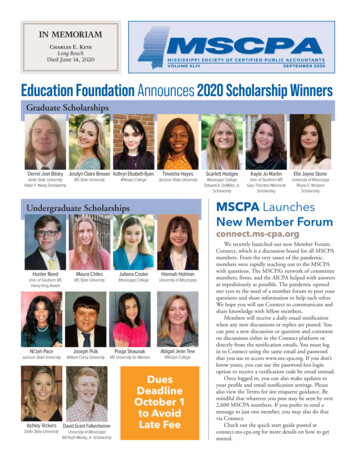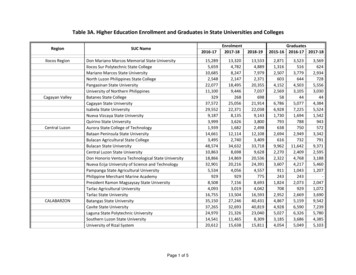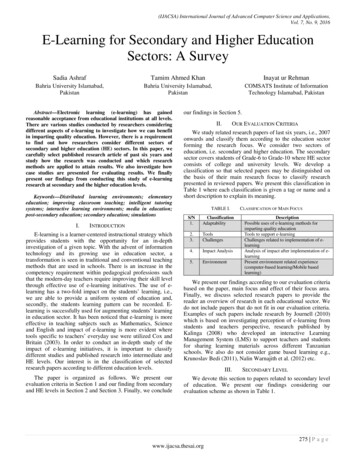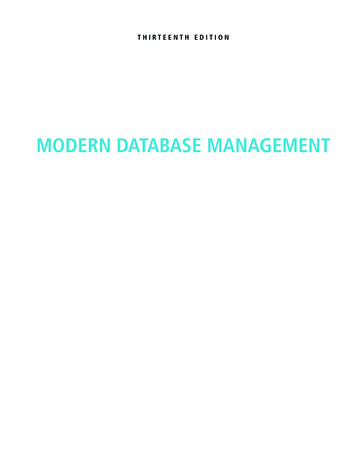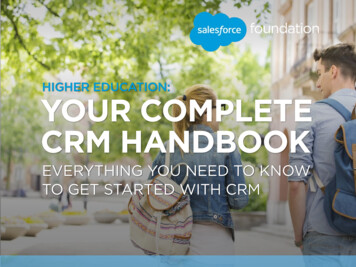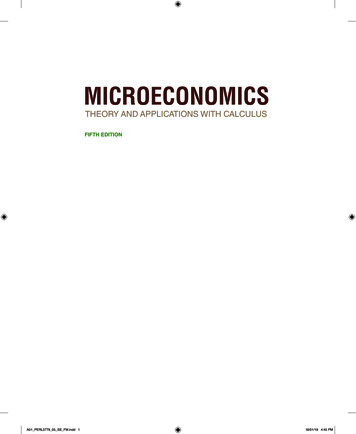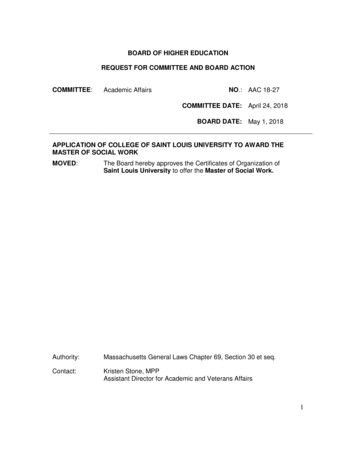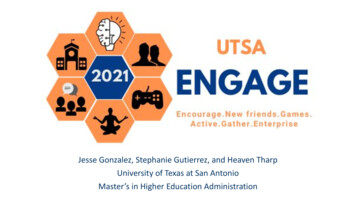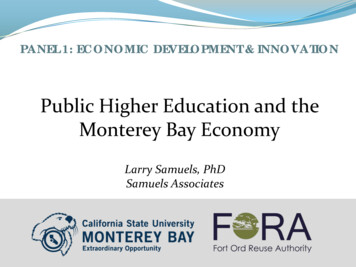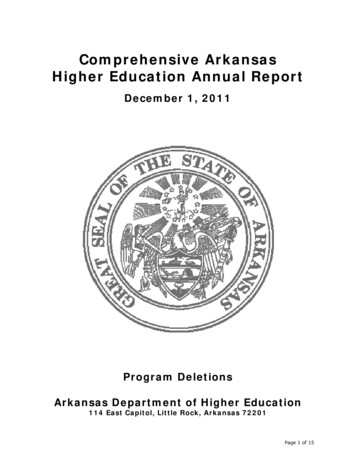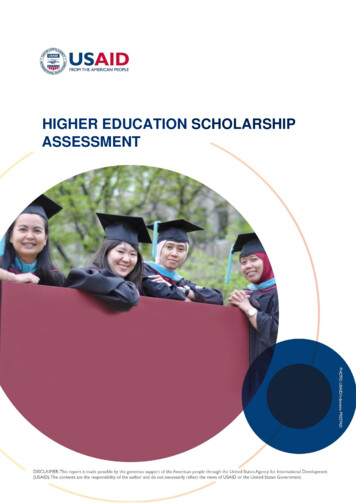
Transcription
HIGHER EDUCATION SCHOLARSHIPASSESSMENTASSESSMENTASSESSMENT1 HIGHER EDUCATION SCHOLARSHIP ASSESSMENTUSAID.GOV
HIGHER EDUCATION SCHOLARSHIPASSESSMENTFinal ReportUSAID Contract No. AID-497-C-16-00006Indonesia Monitoring & Evaluation Support ProjectFebruary 2020USAID.GOVHIGHER EDUCATION SCHOLARSHIPASSESSMENT 2
CONTENTSLIST OF TABLES4LIST OF FIGURES5ACRONYMS6EXECUTIVE SUMMARY7PRINCIPAL CONCLUSIONS AND RECOMMENDATIONS7ASSESSMENT QUESTION 1: THE MAIN SCHOLARSHIP PROVIDERS7ASSESSMENT QUESTION 2: DRIVING FACTORS8ASSESSMENT QUESTION 3: NEEDS FOR ASSISTANCE8ASSESSMENT QUESTION 4: MONITORING AND EVALUATION91. INTRODUCTION92. ASSESSMENT QUESTIONS103. METHODOLOGY103.1 ASSESSMENT STAGES113.2 POPULATION AND SAMPLING113.3 LIMITATIONS124. THE MAIN PROVIDERS OF SCHOLARSHIPS IN INDONESIA124.1 OVERVIEW OF GRADUATE DATABASE134.2 NATIONAL SCHOLARSHIP PROVIDERS154.3 SUBNATIONAL SCHOLARSHIP PROVIDERS174.4 PRIVATE/CSO PROVIDERS184.5 INDONESIA’S MAIN SCHOLARSHIP PROVIDERS195. DRIVING FACTORS215.1 DEVELOPING HUMAN RESOURCES225.2 GOVERNMENT MANDATE245.3 DISASTER RESPONSE245.4 SUPPORT FOR HIGH ACHIEVERS256. TECHNICAL ASSISTANCE NEEDS266.1 INTERNATIONAL PARTNERSHIPS AND CO-FUNDING276.2 MONITORING AND EVALUATION AND IT SUPPORT296.3 KNOWLEDGE EXCHANGE AND CAPACITY BUILDING296.4 SUPPORT SERVICES306.5 HUMAN RESOURCES PLANNING317. MONITORING AND EVALUATION327.1 PROVIDERS WITH DEFICIENT M&E INFORMATION337.2 MISMATCH BETWEEN ANTICIPATED IMPACT AND M&E358. CONCLUSIONS AND RECOMMENDATIONS3 HIGHER EDUCATION SCHOLARSHIP ASSESSMENT37USAID.GOV
8.1 CONCLUSIONS378.2 RECOMMENDATIONS38TARGET PROVIDERS38UNDERSTANDING CONTEXT38TECHNICAL ASSISTANCE38MONITORING AND EVALUATION39REFERENCES40ANNEX I: KEY INFORMANTS41ANNEX II: METHODOLOGICAL OVERVIEW42Annex III: Supplementary database46Annex IV: graduate Database Excerpt49ANNEX V: PRESTASI AND MRTHE SUPPORT SERVICES53LIST OF TABLESTable 1. Graduate Scholarship Database13Table 2. Scholarship Providers and Budgets14Table 3. International Study Options Among National Providers16Table 4. Support Services by National Providers16Table 5. Support Services at The Subnational Level18Table 6. Support Services by Private/CSO Providers18Table 7. The Main Providers of Graduate Scholarships20Table 8. Scholarship Provider Type and Driving Factors21Table 9. Distribution of Scholarship Providers’ Assistance Needs27Table 10. Need For Support Services30Table 11. Scholarship Providers Without M&E Systems or Data On Program Impacts34Table 12. Comparison of Anticipated Impact and Existing M&E Practices35Table 13. Analytical Framework41Table 14. Analytical Framework42Table 15. Supplementary Scholarship Database46Table 16. Scholarship Annual Budget In The Supplementary Database47Table 17. Prestasi and MRTHE Support Service49Table 18. Prestasi and MRTHE Support Services53USAID.GOVHIGHER EDUCATION SCHOLARSHIPASSESSMENT 4
LIST OF FIGURESFigure 1. Two Stages of Data Collection and Analysis11Figure 2. Provincial Graduate Scholarship Providers17Figure 3. Areas Requiring Assistance26Figure 4. Impact and M&E System Among Providers33Figure 5. Number of Scholarship Recipients In The Supplementary Database475 HIGHER EDUCATION SCHOLARSHIP ASSESSMENTUSAID.GOV
ACRONYMSAMINEFAmerican Indonesian Exchange FoundationBappenasBadan Perencanaan Pembangunan Nasional (National Development PlanningAgency)BKDBadan Kepegawaian Daerah (Regional Personnel Agency)BKKBNBadan Kependudukan dan Keluarga Berencana Nasional (National Populationand Family Planning Agency)BMKGBadan Meteorologi, Klimatologi dan Geofisika (Meteorology, Climatology andGeophysics Council)BPSBadan Pusat Statistik (Statistics Indonesia)BPSDMBadan Pengembangan Sumber Daya Manusia (Human Resources DevelopmentAgency)CDCSCountry Development Cooperation StrategyCSOCivil Society OrganizationFETAFinancial Education and Training AgencyGoIGovernment of IndonesiaGMATGraduate Management Admission TestGPAGrade Point AverageGREGraduate Record ExaminationIIEFIndonesian International Education FoundationLPDPLembaga Penjamin Dana Pendidikan (Indonesia Endowment for Education)LPPLembaga Pengembangan Pendidikan (Education Development Agency)M&EMonitoring and EvaluationMCIMinistry of Communication and InformaticsMOECMinistry of Education and CultureMOFMinistry of FinanceMORAMinistry of Religious AffairsMRTHEMinistry of Research, Technology and Higher EducationPGIPersekutuan Gereja-Gereja di Indonesia (Council of Churches in Indonesia)PrestasiProgram to Extend Scholarships and Training to Achieve Sustainable ImpactsRPJMNRencana Pembangunan Jangka Menengah Nasional (Midterm NationalDevelopment Plan)STEMScience, Technology, Engineering and MathematicsYKSEYayasan Karya Salemba Empat (Karya Salemba Empat Foundation)YTAYayasan Toyota Astra (Toyota Astra Foundation)USAID.GOVHIGHER EDUCATION SCHOLARSHIP ASSESSMENT 6
EXECUTIVE SUMMARYThe scholarship landscape assessment was implemented to fulfill two purposes: (a) map thescholarship programs funded by national and provincial governments in Indonesia and (b) identifychallenges and recommend technical assistance needed regarding scholarship programs inIndonesia.The scope of work includes the following four questions:1. Who are the current main players in managing graduate scholarship programs?2. What factors drive the Government of Indonesia (GoI) and other scholarship providers inproviding scholarship programs?3. What are some of the aspects that require most support in managing scholarshipprograms?4. How effective is the monitoring and evaluation (M&E) system of the scholarship providers?(How effectively do they measure the impact of the scholarship program?)The assessment primarily utilized a qualitative methodology. Identification of the main players ofgraduate scholarship programs for the first assessment question occurred through categorizationof scholarship information and descriptive statistics from a review of scholarship providers’documents and websites, as well as through an online survey. To address the last threeassessment questions, interviews with key informants took place in September and October 2019,followed by thematic analysis of the qualitative data from the interviews.This assessment contains several limitations. First, the inability to conduct face-to-face interviewswith informants from provincial scholarship providers may have hindered full comprehension ofthe information conveyed. Second, the use of an e-survey to the private scholarship providersyielded little information. Third, scholarship providers did not disclose complete information aboutthe scholarships, particularly information regarding finance. Finally, the restive Papua and WestPapua provinces could not be contacted due to the security turbulence that occurred inSeptember 2019.PRINCIPAL CONCLUSIONS AND RECOMMENDATIONSASSESSMENT QUESTION 1: THE MAIN SCHOLARSHIP PROVIDERSConclusion: National government institutions provide most graduate scholarships in Indonesia.The Indonesia Endowment for Education (Lembaga Penjamin Dana Pendidikan, or LPDP) hasby far the largest budget and supports more scholarships than do other providers. Provincialgovernments also have substantial funding to support overseas studies but are smaller thannational providers; only one of them included the United States as a study destination. Privateproviders generally lack overseas study options.Recommendation: USAID could focus on providing technical assistance to the nationalscholarship providers as they have the funding and resources to work on improving theirscholarship management. Provincial governments identified as main providers in this assessmentalso have funding to enable overseas studies. Private providers may not be the best option forsupport as they focus on domestic partial undergraduate scholarships.7 HIGHER EDUCATION SCHOLARSHIP ASSESSMENTUSAID.GOV
ASSESSMENT QUESTION 2: DRIVING FACTORSMultiple factors drive most scholarship providers, with the most common being human resourcedevelopment. Government mandates are also an important driver among government institutions.Other salient driving factors, including support of provincial high achievers1 and disaster response,are present but more often a concern of provincial governments and private providers’ agendasthan a national concern.Recommendation: USAID could consider two factors in working with the targeted providers:1. Factors driving the provision of scholarships.It is logical to focus on assisting scholarship providers that are driven by the more permanentagenda of developing human resources. However, other factors, such as government mandates,also influence this driver. In this case, as exemplified by provincial providers, the longevity of thescholarship programs might be uncertain; it may depend on the agenda of the ruling governmentand thus can change with election cycles. Support for politically driven scholarship funds may bewarranted, but USAID would have to readjust technical assistance as agendas and programschange.2. Organizational nature of the targeted scholarship providers.Some provincial providers were established specifically for administering scholarships and mightbe temporary agencies. Risk mitigation is always necessary in designing technical assistanceprograms, but special attention is warranted when working with ad hoc provincial scholarshipagencies.ASSESSMENT QUESTION 3: NEEDS FOR ASSISTANCEConclusion: Scholarship providers identified a variety of assistance needs, but the most frequentlymentioned was building collaboration with international educational institutions. Numerousproviders also mentioned the need for co-funding with international governments and universities,demonstrating a preference for value-for-money overseas study destinations by negotiating lowercosts to fund a larger number of scholarships. Scholarship providers also had a variety ofindividual needs in scholarship management, which could not be generalized across providers2.The experience of USAID’s Prestasi Scholarship Program can be considered a “best practice”example in scholarship management and USAID should consider lessons from this program asfuture programs are developed. Prestasi has developed specific and effective scholarship supportsystems, including for the application process and pre-departure orientation, as well as formonitoring scholars and scholarship effectiveness and building linkages with Americanuniversities.Recommendation: USAID could consider providing the following technical assistance:1. Help facilitate special agreements between scholarship providers and U.S. universities.1Provincial high achievers refer to citizens of a province who have academic and non-academic achievements,e.g., athletes and artists.2 These individual needs include better financial reporting, improvement of research output, negotiating withregional parliamentsUSAID.GOVHIGHER EDUCATION SCHOLARSHIP ASSESSMENT 8
2. Create a hub for learning and disseminating best practices in scholarship managementbetween both the Indonesian scholarship providers and international organizations anduniversities.3. Create a marketplace forum where scholarship providers and other co-funding collaboratorsmeet physically or virtually.4. Increase interest in studying in the U.S. by addressing problems in Indonesian scholarshipcandidates’ reluctance to sit for graduate admissions tests such as the GMAT and GRE.USAID can work with other U.S.-sponsored agencies such as EducationUSA and theAmerican Indonesian Exchange Foundation (AMINEF) to educate the public about theAmerican graduate education system and the strategies to succeed in standardized academicand admissions tests.5. Share best practices in scholarship management based on lessons learned from the PrestasiScholarship Program.ASSESSMENT QUESTION 4: MONITORING AND EVALUATIONConclusion: Existing M&E systems are underdeveloped and not suitable to measure the varietyof anticipated scholarship impacts. Conversely, anticipated scholarship impacts are poorlydefined and difficult to measure. Most provincial and private scholarship providers have a poorconceptualization of M&E and how to build and effectively use such systems.Recommendation: Assistance in this area could begin with an assessment of M&E knowledgeamong the targeted providers. For scholarship providers with clear M&E planning and objectives,USAID can help formulate realistic impact objectives, design systems to measure the objectivesand train the staff in M&E. Providers without an M&E system, or those that have a poorunderstanding of M&E needs related to measuring scholarship impact, will require help buildingbasic capacity, including systems.1. INTRODUCTIONWhile Indonesia allocates 20 percent of its annual budget to education, participation in highereducation, particularly for graduate programs, continues to be low in comparison to its closestneighbors, such as Malaysia, Thailand and Singapore. The quality of its higher education iscomparatively low (Sutrisno, 2019). Nevertheless, the Government of Indonesia (GoI) places ahigh priority on developing human resources in the next Midterm National Development Plan(Rencana Pembangunan Jangka Menengah Nasional, or RPJMN, 2020-2024). A main agendaof the RPJMN is increasing the quality and competitiveness of Indonesian human resources, andthe higher education sector is expected to play a greater role in achieving this throughimprovement in innovation and technology creation. The RPJMN calls for an increasedparticipation rate in the higher education sector to fast-track the nation’s progress in creating ahigh-quality and productive workforce (RPJMN Technocratic Plan 2020-2024). The provision ofscholarships, particularly at the graduate level, is one way to achieve this agenda. The GoI andthe private sector have been supporting the growth of scholarships for graduate education.Since the 2012 launch of the flagship graduate scholarship program, the Indonesia Endowmentfor Education (Lembaga Penjamin Dana Pendidikan or LP
example in scholarship management and USAID should consider lessons from this program as future programs are developed. Prestasi has developed specific and effective scholarship support systems, including for the application process and pre-departure orientation, as well as for monitoring scholars and scholarship effectiveness and building linkages with American universities. Recommendation .
